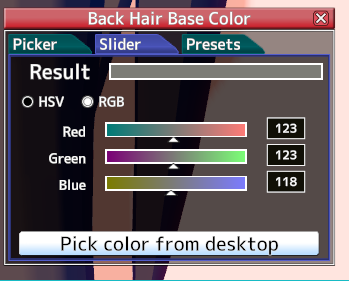It would be a neat idea to automatically get the color values from koikatsu, but the game applies a saturation filter (called Amplify Color) to everything on screen. Directly reading the raw values into blender will give you duller, lighter versions of each color because they aren't going through this saturation process. In order for this to work, each color would need to be converted.
There are tools like https://github.com/ManlyMarco/KK_BetterColorPicker and https://koikoi.happy.nu/texture_color_adjuster/ that use the rgb values and a lookup texture to UNsaturate a color with code showing step by step how it's done, but I have no idea how the actual lookup process works, so I don't know if this process can used in reverse to generate the saturated version of the color.
Amplify Color is now a free asset on the unity store, but I don't know if the code or process for the package is even available to view so it can be recreated in blender. The LUTs that the game uses are at least available in the BetterColorPicker repository above, so it's really just the process that needs to be figured out.
So without Amplify Color's code, and without a similar saturation process, there'd be no point in trying to do this. The next best thing is the current process, where you manually click on a screenshot that already has the saturation filter applied.

 The image on the right is the corrected color.
The image on the right is the corrected color.







 In KKBP:
In KKBP:

 KKBP
KKBP

 KK
KK

in game you can use material inspector to view all values for colors and stuff, so can you make it when you import your textures a gui will pop up asking you for numbers/colors for each material, which correspond the the material inspector. so you just enter them and press ok and it will automatically fix all the colors for you